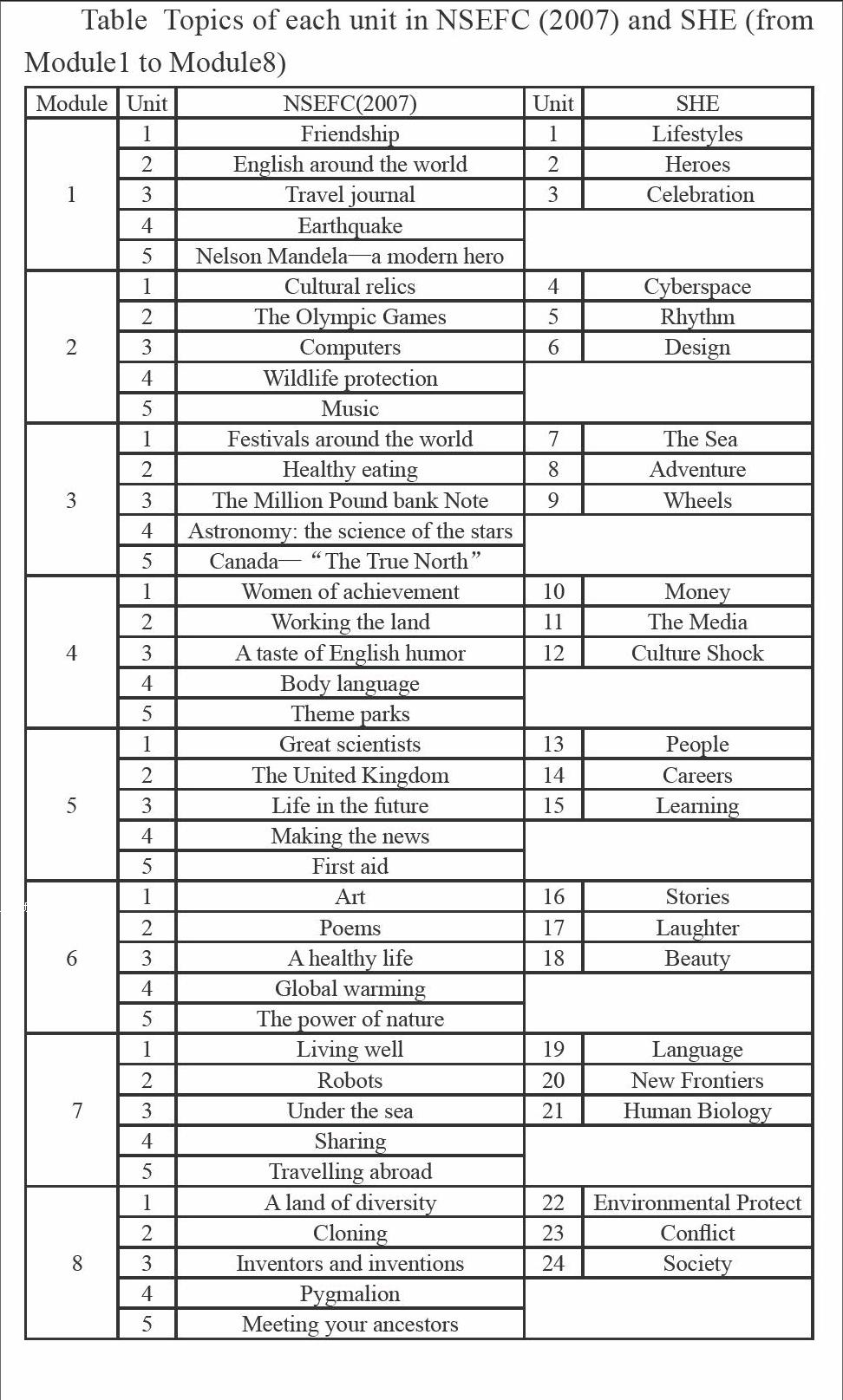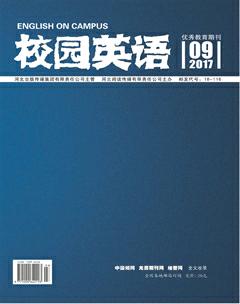Comparison and Analysis of Topics in Textbooks

【Abstract】This research chooses two sets of textbooks: New Senior English for China — NSEFC (2007) and Senior High English (SHE) and then compares and analyzes content arrangement and topics in the two sets of textbooks involved in the study. The two sets of textbooks are all based on the new curriculum standard while they have different arrangements in each unit and each module, but the objectives and demands for the senior students and the role in the teaching are the same.
【Key words】New Senior English for China—NSEFC (2007) textbooks; Senior High English (SHE) textbooks; modules and topics
Since 2010, New Senior English for China (NSEFC) (2007) textbooks have been used by all the senior high schools in Gansu Province. As the being used English teaching material in senior middle school in Gansu Province, evaluating its quality and value is of great significance. Moreover, comparison and analysis of two textbooks can give the teachers and learners more reasonable guidance.
1. Principles of course book design and compilation
Bell and Gower (1998: 122-5) started by articulating the following ten principles:
1. Flexibility 2. From text to language 3. Engaging content 4. Natural language 5. Analytic approaches 6. Emphasis on review 7. Personalized practice 8. Balance of approaches 9. Learner development 10. Professional respect
The ten principles take account of language, approaches, learners and practice. They involve many respects, such as natural language, balance of approaches and learner development.
There are six principles of materials design identified by Nunan (2001):
1. Materials should be clearly linked to the curriculum they serve;
2. Materials should be authentic in terms of texts and tasks;
3. Materials should stimulate interaction;
4. Materials should allow learners to focus on formal aspects of the language;
5. Materials should encourage learners to develop learning skills, and skills in learning;
6. Materials should encourage learners to apply their developing skills to the world beyond the classroom.
The principles identified by Nunan emphasize learners further development and refer to the curriculum related to materials.
English curriculum standard proposed four principles in English materials development: ideological education, scientific principle, delight principle and flexibility principle. (Cheng Xiaotang & Sun Hui, 2011)
1. Ideological education. Ideological education is one of the important contents for secondary and primary schools in China. So materials development is trying to put ideological education in language teaching. Ideological materials need to be chosen to achieve ideological education.
2. Scientific principle. Materials development should proceed in an orderly way and step by step and follow the principles from easy to difficult. Teaching materials should be systematical in content, objectives and demands.
3. Delight principle. Learning motivations depend mainly on interest. Thus English teaching materials should inspire learners interest in form and content to develop and keep learners learning interest.
4. Flexibility principle. Flexibility of materials embodies more extra content provided than actual need. So the contents of materials should be flexible and alternative.
2.1 Comparison of the content arrangement of NSEFC (2007) and SHE textbooks
The orders of grammar presentation in two sets of textbooks are not identical because of different learning materials, so content arrangement in two sets of textbooks need to be compared. The two sets of textbooks have different arrangements in each unit and each module, but the objectives and demands for the senior students and the role in the teaching are the same.
In NSEFC (2007) textbooks, each unit contains warming up, pre-reading, reading, comprehending, learning about language, using language, learning tip and reading for fun. While in SHE textbooks, from Module 1 to Module 5, each module has 3 units and each unit has 4 lessons, Communication Workshop, Culture Corner, Bulletin Board and Unit Diary. Module 6 to Module 8, each unit has 3 lessons, Communication Workshop, Culture Corner, Bulletin Board and Unit Diary, besides, it adds Languages Awareness to each unit. In NSEFC (2007) textbooks, each unit is by means of warming up to lead in. Warming up of each unit supplies much information for learners and makes them interested in the topic. After reading the materials, learners get much language information. All the materials are authentic and learners acquire language based on observe, compare, summarize and practice. Especially, learning tip and reading for fun in each unit expand learners vocabulary and interest in language.
Listening material is well recorded and provide real context, such as conversation at the airport, in a shop, at the doctor and so on. In SHE textbooks, each unit contains Communication Workshop to help students practice speaking and writing and equip them for real life interaction. In NSEFC (2007) textbooks, before a new unit learners are inspired to brainstorm about this topic for warming up to recall the information they have. After learners learn the part of Learning about Language, they can practice their integrated skills: listening, speaking, reading and writing. Many excellent reading materials are chosen to the two sets of textbooks to expand input for learners. After they read, understand and digest, learners learn to use the language.
2.2 Comparison of modules and topics of NSEFC (2007) and SHE textbooks
From one unit we can see some differences in content arrangement in two sets of textbooks. This part compares NSEFC (2007) textbooks and SHE textbooks in general, which contain 11 series textbooks from Module 1 to Module 11. About NSEFC (2007) textbooks, each module has 5 units based on topics, functional items, structures, reading, writing and workbook. While each of SHE textbooks has 3 units according to units/lessons, function, grammar, vocabulary, reading, listening, speaking, writing, language power to organize the content. In curriculum standard students who have learned Module1 to Module8 can achieve the required level from high school. The following is a table to compare topics of each unit in NSEFC &SHE from Module1 to Module8:
From the table we can see that many topics in two sets of textbooks are similar. For example, Unit5 Nelson Mandela-a modern hero in Module 1 (NSEFC) has the similar topic of Unit2 in Module1 of SHE. Unit2 English around the world in Module1 (NSEFC) and Unit19 Language in Module7 of SHE have the same topic. In NSEFC textbooks Unit4 Wildlife protection in Module2 and Unit4 Global warming in Module6 have the similar topic of Unit22 Environmental Protect in Module8 in SHE textbooks. In NSEFC textbooks Unit1 Festivals around the world in Module3 and in SHE textbooks Unit3 Celebration in Module1 are both about festivals. In NSEFC textbooks there is a unit Poems in Module6, while in SHE textbooks there is a unit Rhythm in Module2. In the two sets of textbooks the topics are involved people, sea, environment, science, literature and culture.
However, there are some differences about topics. In NSEFC textbooks topics of Unit4 Pygmalion and Unit5 Meeting your ancestors in Module8 arent involved in SHE textbooks. Topics involved in Unit12, Unit14, Unit20 and Unit23 in SHE textbooks couldnt be found in NSEFC textbooks.
3. Conclusion
The research compares and analyzes the topics, content arrangement, in two sets of textbooks and comes to the conclusion.The two sets of textbooks are all based on the new curriculum standard while they have different arrangements in each unit and each module, but the objectives and demands for the senior students and the role in the teaching are the same. The two sets of textbooks have different characteristics, on the whole, NSEFC (2007) textbooks are simplified in structure; while the structure and reading materials in SHE textbooks are more varied, so undeveloped Gansu Province choose NSEFC (2007) textbooks for learners and teachers.
References:
[1]Bell,J.and R.Gower(1998).Writing course materials for the world:a great compromise.In materials development in language teaching[M].Cambridge:Cambridge University Press.
[2]Nunan David(2001).Second language teaching and learning[M].Beijing:Foreign Language Teaching and Research Press and Heinle & Heinle/Thomson Learning Asia.
[3]陳军.从学习者需求的角度看新课标英语教材Go For It在重庆地区的适用性[D].重庆大学,2007.
[4]课程标准研制组.英语课程标准(实验)解读[M].南京:江苏教育出版社,2004.
*此文为兰州市教育科学“十二五”规划课题《新课程实施中普通高中英语教材多样化研究——以新人教版和北师大版为例》阶段性研究成果。同时也是甘肃省教育科学“十二五”规划课题《新课程实施中普通高中英语教材多样化研究——以新人教版和北师大版为例》阶段性研究成果。课题批准号:GS[2013]GHB1174。
作者简介:李晓燕(1978-),女,汉族,甘肃武威人,兰州市第九中学一级教师,研究方向:中学英语教学与理论。

